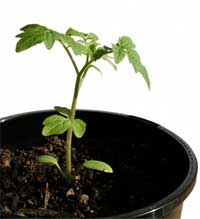 by Rachel Berman RD, Director of Nutrition, CalorieCount.com
by Rachel Berman RD, Director of Nutrition, CalorieCount.com
Growing your own food sounds very overwhelming but you can do it easily with very little space, even in an urban environment. March is also the perfect time to start preparing your own garden to grow plants and herbs for the spring and summer months ahead. As if you need reasons why, it ensures you have fresh produce on hand, is a great way to teach your children about eating healthy, can help you save money, plus studies show that gardening relieves stress! From an environmental standpoint, you can help decrease pollution by growing without the use of pesticides and reduce the need for trucks that transport food all over the country. Finally, what could taste more delicious than a plant that you grow and pluck at its peak of ripeness just steps away from your kitchen door?
Contain your garden
Many people in urban environments do not have a backyard let alone a square foot of land to grow plants. By practicing ‘container gardening’, basically growing in any sort of container that can hold soil, plants and drain water, you can bring your garden to a patio, or even indoors as long as there is plenty of sunshine. Check out this comprehensive guide to how to get started with container gardening and what fruits, vegetables, and herbs are easiest to grow.
Garden to kitchen
Carrots
Growing: Use a deep container, at least 12 inches, for most varieties of carrots. Harvest anywhere between 50 and 80 days.
Nutrition: Great source of vitamin A in the form of beta-carotene which is vital for eye and skin health and immunity.
Kitchen: Carrots are very versatile and can be eaten raw, in salads, stir-fries, summer soups, or even grated into muffin or pancake mixes for extra moistness and nutrients. Try this Risotto with Spring Carrots and Leeks recipe.
Kale
Growing: Kale can be grown in containers 10-12 inches wide and needs about 2 months of cool weather to grow.
Nutrition: Great source of glucosinolates which are compounds that have cancer-preventive properties.
Kitchen: Kale has a somewhat bitter, yet rich flavor taste and is growing quickly in popularity. It can be eaten raw in salads, sautéed down for soup bases and stir fry, and tossed with olive oil then baked to make kale chips.
Spinach
Growing tips: Spinach can be grown in containers at least 6 inches deep. Spinach is heat-sensitive so move into shade on hot days.
Nutrition: Rich in folate and antioxidants which are important for heart health.
Kitchen: For use in salads, on sandwiches, paired with fish or meat, in pastas, quiche or frittatas. If your child is not a big veggie fan, you can hide 3 cups of spinach in a “Green Monster” smoothie along with banana, a tablespoon of almond butter, 6 oz non fat vanilla Greek yogurt, and a cup of almond milk.
Parsley
Growing: Parsley can be grown indoors for year-round enjoyment. Needs sun exposure for 6 hours per day or artificial light for 14 hours per day.
Nutrition: Good source of vitamin C for healthy joints and fighting infection.
Kitchen: Parsley is often used as garnish for a variety of dishes, or but can also add flavor to just about anything. Parsley can also be one of the main attractions in a dish like tabbouleh.
Also check out, Sprout Robot! An excellent site that outlines step-by-step how and what to grow depending on your location and space requirements.
Also Read:
Attack of the Antibiotic Vegetable
Jennie Garth’s Gardening Debut
